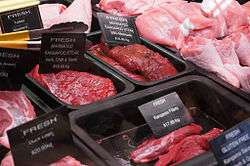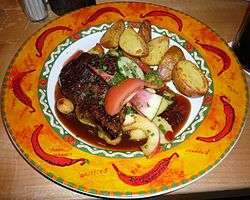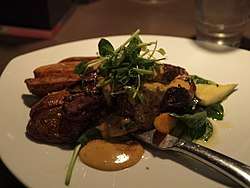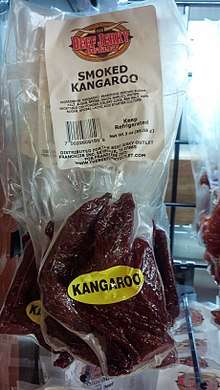Kangaroo meat
Kangaroo meat is mostly produced in Australia from wild kangaroos and in 2010 was exported to over 55 countries worldwide.[1]

Production
Currently most kangaroo meat is sourced from wild animals as a byproduct of population control programmes.[2][3] Both the meat and the hides are sold. Although most species of macropod are protected from non-Aboriginal hunting by law, a small number of the large-sized species which exist in high numbers can be hunted by commercial hunters.[4] This policy has been criticised by some animal rights activists.[5] On the other hand, the kangaroo harvest is supported by a wide range of professional ecologists in Australia. Groups such as the Ecological Society of Australia, the Australasian Wildlife Management Society and the Australian Mammal Society have stated their support for kangaroo harvesting. Such groups argue that basing agricultural production systems on native animals rather than introduced livestock like sheep offers considerable ecological advantages to the fragile Australian rangelands and could save greenhouse gas emissions.[6][7]
Though it is impossible to determine the exact number, government conservation agencies in each state calculate population estimates each year. Nearly 40 years of refinement has led to the development of sophisticated aerial survey techniques which enable overall populations estimates to be constructed.[8] Current estimates indicate that there may be between 35 and 50 million kangaroos in Australia.[9][10] In 2002, the number of kangaroos allowed to be shot by commercial hunters was increased from 5.5 million to 7 million per year.[11] While animal rights activists protested the move, Australian farmers said that kangaroos were a plague after a huge increase in their numbers.[12] A 2002 report studying the grazing pressure caused by kangaroos indicated that scientific evidence is lacking that kangaroos reduce wool production or sheep carrying capacity.[13] In 2007, the national kangaroo culling quota was more than 3.5 million[14] (but significantly down on the figures earlier in the decade).
Kangaroos are protected by legislation in Australia, both state and federal. Kangaroos are harvested by licensed shooters in accordance with a strict code of practice. Meat that is exported is inspected by the Australian Quarantine and Inspection Service (AQIS).[3][9]
The quotas created in Australia are the responsibility of each state or territory government. For example, in Queensland, only the following species (up to 2017) were included in the quota: red kangaroo, eastern grey kangaroo, common wallaroo. "Sustainable use quotas" are typically between 10–20% of the kangaroo estimated population. Culling is only allowed in certain state areas by approved shooters. Total populations are estimated by aerial surveys and a decade of previous data. Quota numbers calculated by government and science organisations to ensure sustainability. Even though quotas are established by each state, very rarely does actual culling reach 35% of the total quotas allowed. For instance, "[i]n the 2015 harvest period, 25.9% of the commercial harvest quota (for Queensland) was utilised".[15] In NSW, private cullers had to "shoot and let lie" the carcasses of kangaroos. Drought relief laws have changed this, allowing farmers to produce kangaroo meat.[16]
Nutrition and products



The kangaroo has been historically a staple source of protein for indigenous Australians. Kangaroo meat is high in protein and low in fat (about 2%). Kangaroo meat has a very high concentration of conjugated linoleic acid (CLA) when compared with other foods. CLA has been attributed with a wide range of health benefits including anti-carcinogenic and anti-diabetes properties, in addition to reducing obesity and atherosclerosis.[3][9][17]
While kangaroo meat has enjoyed popularity for its organic nature, little information has been available about its nutrition benefits besides articles dedicated to the value of CLA's. While basic nutritional data (total protein, fats etc.) are published worldwide, little research has been provided about the nature of the kangaroo protein and its composite amino acid profile. Of the 22 amino acids within protein, ten are vital to human and animal well-being because they can't be manufactured in the body. These are called 'essential amino acids' and the primary research on kangaroo muscle meat nutrition is from a seminal research paper by the primary Australian government science organisation CSIRO in 1970.[18]
Using this research paper as a primary data source essential amino acids have been calculated for dried kangaroo muscle meat (DM) and compared to various other farmed meat sources such as chicken, pork, beef and lamb.[18] By comparison to these farmed meats, kangaroo meat is higher in threonine, isoleucine and valine and lower in arginine and methionine-cystine amino acids. This information is invaluable in calculating balanced diets or when a subject requires an extra natural source of a specific essential amino acid.
Kangaroo meat was legalised for human consumption in South Australia in 1980.[19] In New South Wales, Queensland, and Victoria it could only be sold as pet food until 1993.[20] Kangaroo was once limited in availability, although consumption in Australia is becoming more widespread. However, only 14.5% of Australians were reported in 2008 as eating kangaroo meat at least four times per year.[21] Many Australian supermarkets now stock various cuts of kangaroo[3][22] including fillets, steaks, minced meat and 'Kanga Bangas' (kangaroo sausages). Many Australian restaurants serve kangaroo meat.[23]
Kangaroo meat has been exported since 1959.[21] Seventy percent of kangaroo meat is exported, particularly to the European market: Germany and France.[19] It is sold in two supermarkets in the United Kingdom[22] and before a suspension on imports of kangaroo meat to Russia in 2009 it was widely used in Russian smallgoods.[24] In 2008, the industry is worth around A$250-270 million a year and provides around 4,000 jobs in Australia.[19][21]
The meat is also processed into pet food.[19] The small kangaroo farming community is a more environmentally friendly meat industry than sheep or cattle farming since kangaroos require no processed feed, are well-adapted to drought, and do not destroy the root systems of native grasses.[3] However, as of 1983, kangaroo farming is economically unattractive due to the start up costs and inability of the farmed product to compete financially against animals that have been killed by hunters under the government quota system.[25]
Cooking
Due to its low fat content (1-2%), kangaroo meat cannot be cooked in the same way as other red meats. Slow cooking is recommended for kangaroo,[26] or quickly stir-frying.[27]
Animal welfare issues
The kangaroo meat industry has attracted critical attention in Australia, the United Kingdom and the United States from animal welfare organisations. These concerns have centred on the hunting process, in which all kangaroo meat for the global market comes from kangaroos hunted in the wild. Australia's kangaroo hunting programme is the largest annual wildlife hunting programme in the world. A 2009 report from wildlife ecologist Dr Dror Ben-Ami for a University of Technology Sydney think-tank estimated that 440,000 "dependent young kangaroos" are bludgeoned or starved to death each year after their mother has been shot. The report also raised serious public health and sustainability concerns.[28][29]
In the United Kingdom, the sale of kangaroo meat has prompted protests from animal welfare campaigners. German retailer Lidl announced in 2018 that it would stop selling kangaroo steaks following "customer feedback".[30] Iceland, Tesco and Morrisons have previously stopped selling lines of kangaroo meat.[31]
Kangatarianism
Kangatarianism is a recent practice of following a diet which excludes meat except kangaroo on environmental and ethical grounds. Several Australian newspapers wrote about the neologism "kangatarianism" in February 2010, describing eating a vegetarian diet with the addition of kangaroo meat as a choice with environmental benefits because indigenous wild kangaroos require no extra land or water for farming and produce little methane (a greenhouse gas), unlike cattle or other farm animals.[32][33] Advocates of kangatarianism also choose it because Australian kangaroos live natural lives, eat organic food, and are killed "humanely".[34][35] For similar reasons, Australians have discussed eating only the meat of Australian feral camels ("cameltarianism").[36]
Name
There has been recent discussion from the kangaroo meat industry about attempting to introduce a specific culinary name for kangaroo meat, similar to the reference to pig meat as ham and pork, and calling deer meat venison. The motivation is to have diners thinking of the meat rather than the animal and avoiding adverse reactions to the eating of an animal considered to be cute. In 2005 the Food Companion International magazine, with support from the Kangaroo Industry Association of Australia, ran a competition hoping to find a name that would not put diners off when they saw it on a menu. The three-month competition attracted over 2700 entries from 41 nations, and the name australus was decided in December 2005. The name was penned by university professor Steven West, an American about to be naturalised as an Australian citizen. Other finalists for the name included kangarly, maroo, krou, maleen, kuja, roujoe, rooviande, jurru, ozru, marsu, kep, kangasaurus, marsupan, jumpmeat, and MOM (meat of marsupials).[37]
The competition is not binding on the Kangaroo Industry Association, which has not moved to adopt the new name in any official capacity.
Traditional Aboriginal use
Kangaroo formed an important part of many traditional Aboriginal diets.
Kangaroo is called Kere aherre by the Arrernte people of Central Australia:
You find kangaroos in flat country or mulga country. In the old days, people used to sic their dogs on them and spear them. The milk guts are pulled out and a wooden skewer is used to close up the carcase. Then it is tossed on top of the fire to singe the hair which is scraped off, and then it's [put in a hole and] covered up with hot earth and coals. The tail and both feet are cut off before cooking. These are put in together with the rest of the carcase.
The kangaroo is chopped up so that many people can eat it. The warm blood and fluids from the gluteus medius and the hollow of the thoracic cavity are drained of all fluids. People drink these fluids, which studies have shown are quite harmless. Kangaroos are cut in a special way; into the two thighs, the two hips, the two sides of ribs, the stomach, the head, the tail, the two feet, the back and lower back. This is the way the Arrernte people everywhere cut it up.[38]
The Anangu, Pitjantjatjara and Yankunytjatjara peoples of Central Australia call kangaroo "malu". They use malu mainly for meat (kuka) but other uses include materials for spear making. They are an important totem species. The Angas Downs Indigenous Protected Area Rangers are currently undertaking land management activities to increase this important species in the landscape. This process is named Kuka Kanyini – looking after game animals.
See also
| Wikimedia Commons has media related to Kangaroo meat. |
- Kangaroo industry
- Sustainable Wildlife Enterprises
References
- "Background information Commercial kangaroo and wallaby harvest quotas" (PDF). Australian Government: Department of the Environment and Heritage. April 2010. Archived from the original (PDF) on 5 November 2010. Retrieved 23 January 2011.
- "Eat kangaroo to 'save the planet'". BBC News. 9 August 2008. Retrieved 23 October 2008.
- Dow, Steve (26 September 2007). "An industry that's under the gun". Sydney Morning Herald. Retrieved 19 August 2008.
- Kangaroo Biology Archived 29 January 2007 at the Wayback Machine
- "SaveTheKangaroo.com". SaveTheKangaroo.com. Retrieved 23 June 2009.
- Using kangaroos adaptations to produce low-emission meat | Australian Wildlife Services Archived 19 March 2016 at the Wayback Machine
- The kangaroo industry – ecologists and conservationists "Archived copy". Archived from the original on 22 July 2008. Retrieved 21 August 2008.CS1 maint: archived copy as title (link)
- Pople, Tony; Gordon Grigg (August 1999). Commercial Harvesting of Kangaroos in Australia. Department of Zoology, The University of Queensland for Environment Australia. Archived from the original on 30 August 2008. Retrieved 23 October 2008.
- "Kangaroo meat – health secret revealed" (Press release). Commonwealth Scientific and Industrial Research Organisation (CSIRO). 23 April 2004. Archived from the original on 18 March 2007.
- "Factsheet: Australian Wildlife 2". Yptenc.org.uk. 12 May 2009. Archived from the original on 15 July 2007. Retrieved 23 June 2009.
- "Kangaroo cull targets millions". BBC News. 21 February 2002. Retrieved 23 June 2009.
- "Graziers call for mass kangaroo cull". Abc.net.au. 6 August 2002. Retrieved 23 June 2009.
- "UQ eSpace". espace.library.uq.edu.au. Retrieved 23 October 2019.
- "Animal groups plan kangaroo campaign". Sydney Morning Herald (AAP). 17 June 2008. Retrieved 19 August 2008.
- "2017 Quota Submissions for Commercially Harvested Macropods in Queensland" (PDF). www.qld.gov.au. Queensland Government.
- Roy, Tahlia (9 December 2018). "Kangaroos kept eating Martin's grass — so now he's eating them". ABC News. Retrieved 9 December 2018.
- Sinclair, A.J.; O'Dea, K; Dunstan, G; Ireland, P D; Niall, M (July 1987). "Effects on plasma lipids and fatty acid composition of very low fat diets enriched with fish or kangaroo meat". 22 (7). originally published Lipids; abstract republished by International Bibliographic Information on Dietary Supplements database (US Govt: National Institutes of Health/Office of Dietary Supplements and the National Agricultural Library/Agricultural Research Service/Food and Nutrition Information Center): 523–29. Archived from the original (Truncated abstract of article only) on 11 April 2009. Retrieved 19 August 2008. Cite journal requires
|journal=(help) - Simpson, R.J.; Da Vidson, B.E. (1971). "Glyceraldehyde-3-phosphate Dehydrogenase From the Red Kangaroo (Megaleia Rufa): Purification and the Amino Acid Sequence Around a Reactive Cysteine". Aust. J. Biol. Sci. 24 (2): 263–73. doi:10.1071/BI9710263. PMID 5579442.
- Collins, Fiona (22 February 2008). "Kangaroo meets booming export demand". Agribusiness Channel. Investor TV. Archived from the original on 20 July 2008. Retrieved 18 August 2008.
- "Bush food: Kangaroo". The Guardian. 3 January 2014. Retrieved 30 April 2019.
- Ratcliff, Carli (15 October 2008). "Kanga who?". SBS Food. Special Broadcasting Service. Archived from the original on 24 October 2008. Retrieved 23 October 2008.
- Benn, Matthew (4 September 2005). "Kangaroo meat exports jump even as drought culls supply". The Sun-Herald. Retrieved 21 August 2008.
- Rebecca Levingston (10 February 2010). "Kangatarianism – roo stew?". ABC Brisbane. Archived from the original on 31 August 2011. Retrieved 17 January 2012.
- Exporting red meat to Russia: Understanding the context Archived 10 December 2014 at the Wayback Machine, 7 October 2010. Retrieved on 22 October 2010.
- Shepherd, NC (1983). "The feasibility of farming kangaroos". The Australian Rangeland Journal. 5 (1): 35–44. doi:10.1071/RJ9830035.
Markets for meat and skins are limited and are adequately supplied from the existing rangeland harvest (i.e. kangaroo hunting). Farmed kangaroos could not compete successfully in these circumstances because of high costs associated with establishing and operating a kangaroo farming enterprise.
- Wynne, Emma (29 May 2019). "Avoiding rubbery roo and other tricks to cooking with Indigenous foods". ABC News. Retrieved 29 May 2019.
- Mitchell, Scott (24 October 2018). "The best ways to cook and enjoy kangaroo meat - ABC Life". www.abc.net.au. Retrieved 29 May 2019.
- "Archived copy". Archived from the original on 6 October 2016. Retrieved 9 July 2016.CS1 maint: archived copy as title (link)
- "Archived copy". Archived from the original on 10 September 2016. Retrieved 9 July 2016.CS1 maint: archived copy as title (link)
- Grant, Katie (23 March 2018). "Lidl pulls 'deluxe' kangaroo steaks from UK stores". i. Retrieved 23 September 2019.
- Graham, Rachel (23 March 2018). "Lidl to stop selling kangaroo meat from June". The Grocer. Retrieved 23 September 2019.
- Tayissa Barone (9 February 2010). "Kangatarians jump the divide". Sydney Morning Herald. Retrieved 17 January 2012.
- Kerry Maxwell (10 January 2011). "kangatarian". BuzzWord. Macmillan Dictionary. Retrieved 17 January 2012.
- Bonnie Malkin (12 February 2010). "'Kangatarians' emerge in Australia". The Telegraph. Retrieved 17 January 2012.
- Wendy Zukerman (13 October 2010). "Eating Skippy: Is kangaroo the kindest meat?". New Scientist. Retrieved 17 January 2012.
- Ben Schott (23 February 2010). "Kangatarians, Vegeroos & Cameltarians". Schott's Vocab. New York Times. Retrieved 17 January 2012.
- Guerrera, Orietta (20 December 2005). "Australus: a palatable name for our Skippy". The Age. Retrieved 26 August 2008.
- Turner, Margaret-Mary, Arrernte Foods:Foods from Central Australia, IAD Press, Alice Springs, 1994, ISBN 0-949659-76-2 pp. 42–43
External links
- Skippy Size Me 2004 ABC report on kangaroo industry
- Kangaroo Industry Association of Australia
- Greenpeace urges kangaroo consumption to fight global warming, Herald Sun
- Kangaroo Meat

